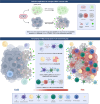Advancing ORFV-Based Therapeutics to the Clinical Stage
- PMID: 40346732
- PMCID: PMC12064845
- DOI: 10.1002/rmv.70038
Advancing ORFV-Based Therapeutics to the Clinical Stage
Abstract
The Orf virus (ORFV) is the prototype member of the parapoxvirus family and has long been recognized for its robust immunogenicity, favourable safety profile and its ability to stimulate both cellular and humoural immune responses without inducing significant anti-vector immunity. Despite these inherent advantages, early applications of ORFV-based technologies were limited by challenges in manufacturing scalability and uncertainties regarding clinical safety in humans. However, recent breakthroughs have transformed this therapeutic landscape. A landmark achievement is the development of Prime-2-CoV, an ORFV-based anti-COVID-19 vaccine that has advanced into human clinical trials, providing the first clinical evidence of live ORFV's feasibility, safety and immunogenicity. This milestone, together with the establishment of a good manufacturing practice (GMP)-compliant production process and comprehensive preclinical evaluations, has laid a robust foundation for broader clinical applications of ORFV-based therapeutics. Moreover, the use of ORFV as an oncolytic virus therapy has shown promising results, effectively converting immunologically 'cold' tumours into 'hot' ones, underscoring its versatility as a therapeutic platform. In this review, we critically assess recent advances in ORFV-based therapeutics, with a particular focus on vaccine development and oncolytic virotherapy (OVT). We thoroughly discuss the milestones and impact of the first ORFV-based clinical trial, outline strategies for optimizing the technology and provide insights into overcoming remaining challenges. Collectively, these advancements position ORFV as a highly promising and versatile platform for next-generation prophylactic and therapeutic interventions in both human and veterinary medicine, while also providing a roadmap for future innovations.
Keywords: ORFV; immune stimulation; immunogenic cell death; oncolytic virus; orf virus; parapoxvirus; vaccine; viral vector.
© 2025 The Author(s). Reviews in Medical Virology published by John Wiley & Sons Ltd.
Conflict of interest statement
R.A. holds ownership interest in Prime Vector Technologies GmbH, a company involved in the development of ORFV‐based vaccines. Additionally, R.A. is an inventor of patents related to ORFV, including a patent application of Prime‐2‐CoV_Beta (EP23730776). M.H. declares no competing interest.
Figures




Similar articles
-
Oncolytic Orf virus licenses NK cells via cDC1 to activate innate and adaptive antitumor mechanisms and extends survival in a murine model of late-stage ovarian cancer.J Immunother Cancer. 2022 Mar;10(3):e004335. doi: 10.1136/jitc-2021-004335. J Immunother Cancer. 2022. PMID: 35296558 Free PMC article.
-
Pharmacokinetic and Environmental Risk Assessment of Prime-2-CoV, a Non-Replicating Orf Virus-Based Vaccine against SARS-CoV-2.Vaccines (Basel). 2024 May 2;12(5):492. doi: 10.3390/vaccines12050492. Vaccines (Basel). 2024. PMID: 38793743 Free PMC article.
-
Oncolytic Parapoxvirus induces Gasdermin E-mediated pyroptosis and activates antitumor immunity.Nat Commun. 2023 Jan 14;14(1):224. doi: 10.1038/s41467-023-35917-2. Nat Commun. 2023. PMID: 36641456 Free PMC article.
-
Orf virus: A promising new therapeutic agent.Rev Med Virol. 2019 Jan;29(1):e2013. doi: 10.1002/rmv.2013. Epub 2018 Oct 28. Rev Med Virol. 2019. PMID: 30370570 Review.
-
Immunomodulatory Strategies for Parapoxvirus: Current Status and Future Approaches for the Development of Vaccines against Orf Virus Infection.Vaccines (Basel). 2021 Nov 17;9(11):1341. doi: 10.3390/vaccines9111341. Vaccines (Basel). 2021. PMID: 34835272 Free PMC article. Review.
References
Publication types
MeSH terms
Substances
Grants and funding
LinkOut - more resources
Full Text Sources
Medical

